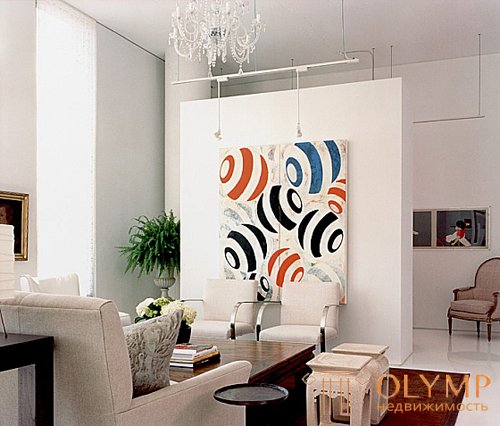
Contemporary ( contemporary ) is a modern concept, as the concept of interior style is related to everything new in today's design that does not fit into the rigid definition of hi-tech or minimalism.
Contemporary - the style of the interior, in which it is difficult to recognize one or another style.
Interiors in the style of contemporary can not be attributed to the traditional styles that cite historical eras, but they also meet the modern requirements of comfort, simplicity, functionality and accessibility. Italians call it “modern” for their commitment to new ideas and technologies.
Contemporary - a massive and affordable style. It will suit everyone who prefers simplicity, convenience, practicality and likes to change the situation in whole or in part every 5-7 years. It is close and understandable to most, quite simple in execution. The basic principle of Contemporary - convenience, simplicity, functionality and accessibility.
The peculiarity of Contemporary is that it, as a rule, manifested itself in the interior spontaneously, and not as a result of a well-thought-out design idea. Hence its eclecticism and “vitality”.

Style Contemporary in the interior, photo
The main features of the style of Contemporary:
It all started after the Second World War, based on the Scandinavian style with the idea of mass production of furniture and household items at affordable prices and acceptable quality, when the symbol of the era appeared - the notorious furniture wall in the living room.
The emergence of the style of “contemporary” was preceded by the ideas of the constructivists V. Kandinsky, K. Malevich, and also the ideas of the Bauhaus by V. Gropius and L. Ms van der Rohe. They sought to offer high-quality furniture to people, and at the same time affordable, technically thoughtful and at the same time elegant. Ideologists of the Bauhaus sought to implement the synthesis of all the arts in the search for new forms. They succeeded in it so much that interior items, developed almost a hundred years ago, today look modern and relevant.
However, the tendencies of the beginning of the last century could not cancel the sadness of the past: good and measured time, traditional notions of beauty, aspirations for comfort, dreams of a house - a “safe haven”. And, as soon as the first euphoria of novelty passed, as soon as the wounds of social upheaval dragged on, humanity again turned to the styles of the past. I remembered balanced classicism, a solemn Empire style, elegant baroque and rococo, intricate modernism, a cozy country style, exotic colonial style ...
People with wealth, as a rule, tried to recreate the atmosphere of respectability by meticulously observing traditional canons. But the masses rethought them at a new level and adapted to the modern way of life. The spirit of the favorite epoch was recreated in modern interiors due to expressive details and decorative elements. This softened the lifelessness of functionalism, the sterility of minimalism, the industrialism of high tech. Dwellings became somehow warmer, warmer and more traditional. Thus was born the "style of stylization" - contemporary-styled.
From the middle of the 20th century, interiors in the style of “contemporary” (by the way, designers use this term to designate any style devoid of obvious belonging to past historical eras, but reminiscent of them) have spread widely throughout the world and it seems that they will not disappear a very long time.
Although the style of “contemporary” is many-sided and diverse, it has been subject to evolutionary changes. And, by the way, the main features inherent in this or that decade, cause today the interest of interior designers with their specific expressiveness.
For example, the “contemporary” of the 50s of the 20th century was under the influence of minimalism all over the world. There were few things in the apartments, and even those were light, very unassuming in silhouette. True, the furniture was quite bright: in juicy and fresh colors. In the Soviet interiors during this period, the opposite situation. In our country, in the post-war years, the “Stalinist Empire” was established, which, as it were, compensated for the years of deprivation with a kind of strict luxury. At this time, houses were built with spacious apartments and high ceilings decorated with stucco. People gladly decorated "mansions" with massive furniture from natural wood, heavy and complex draperies of silk, crystal chandeliers, carpets, bronze, mirrors.
In the 60s, the Soviet interior was on the western path. In the fashion was a low cabinet furniture with thin legs, carob chandeliers and sconces, the characteristic sensual outlines of upholstered furniture. It was all short, compact and cozy. The most expensive and stylish interior decoration is scarce books and rare luxury - a collection of vinyl jazz records.
In the 1970s, pop art came into fashion in the West with its mockery of popular culture. In the Soviet interior there were no major changes, except that it became more difficult to get new furniture, so the apartments were filled with the “what did you get” principle and became more and more eclectic.
The fashion for the 60s has returned and it is now easy to find familiar furniture samples in stores that have been revised and adapted to the requirements of today's life. These are light shelves, couches, walls, built-in wardrobes and racks, padded stools, bedroom sets, etc. Huge supermarkets have such an assortment of goods that they can buy almost all the furnishings of their homes without leaving the store.
To the detriment of the decor, such a style achieves lightness and elegance due to proportionally adjusted laconic lines, while in it you can find elements of various ethnic and classical forms.
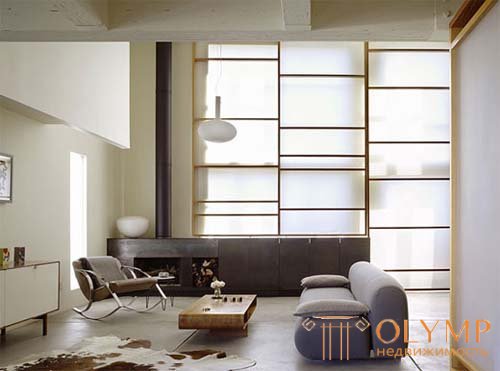
Style Contemporary in the interior, photo
One of the principles of “contemporary” is the mass production of interior items. Not surprisingly, most often the furniture of this style is made of MDF, inexpensive wood, white metal and glass, colored plastic. Since the time of the Bauhaus, the demand for high quality products has not lost relevance, so all these “modest” materials must be carefully processed so that the furniture is reliable, durable and environmentally friendly.
To make furniture comfortable, affordable and aesthetic, manufacturers give it an artless shape. Attractiveness is achieved not due to the abundant decor or textured expressiveness of the material, but due to the elegant outlines - rounded and streamlined.

Style Contemporary in the interior, photo
By the way, for the same reason, the furniture “contemporary” is rarely decorated with complex ornaments (unless it is convenient to “stamp” it on the car). But it often contains color accents, for example, metal shine and rich simple colors: black, white, red, yellow, blue. In general, things in the style of "contemporary" should have a "neutral" look, so as not to seem "chic" or "cheap", "old" or "too new."
The functionality of the situation is explained, first of all, by the need to place it in the limited space of a city typical apartment. So there were "transformers" and "modules" of standard sizes and geometry, optimizing space. The traditional box has given way to a fold-out couch or chair-bed. The chairs are easily placed one on top of the other, like a children's pyramid toy: the guests dispersed, and the lightweight construction moves into the closet so as not to take up space. A bookcase in one of its sections hides a folding or retractable desk. The bookcase for books and colors easily turns into a mobile partition ... And this is not a complete list of the possibilities of furniture in the style of “contemporary”.
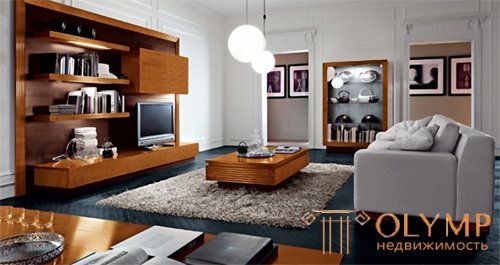
Style Contemporary in the interior, photo
An obligatory element of the interior of this style is storage systems, because in conditions of limited space it can be very difficult to place all the belongings with which a person goes through life. So, it is impossible to do without hidden and open drawers, shelves, racks and, of course, without a furniture wall - the dreams of any normal Soviet person. Closed drawers, as a rule, are designed to store "useful" things that are not accepted to be displayed. But the open ones are meant for the “treasures” dear to the heart: books, souvenirs, photographs, knickknacks. And in this we see another evidence that the ascetic cutting-edge design trends contradict human nature. Man is not a tumbleweed: he needs soil and roots, that is, “memos” and symbols of the past. The style of “contemporary” is so good that it allows everyone to create and demonstrate their own private history in the interior.
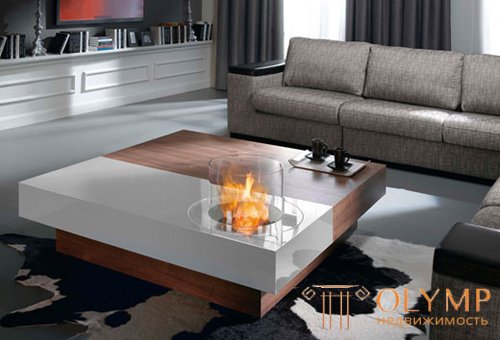
Style Contemporary in the interior, photo
The positive features of contemporary style are the ease of layout, interchangeability of interior items, the possibility of transformations and the integration of furniture into the already existing layout. Disadvantages - some coldness, monotony and facelessness. The apparent "impersonality" of interior items in the style of "contemporary" makes it possible to maximize the personality of the owner of the house. Unlike the “classics”, in which the furniture was “soloed” against the background of walls, floor and accessories, the contemporary-styled furnishing itself is a neutral basis for the realization of decorative fantasies. Textile accessories, bright details, collections of paintings and sculptures, unusual lamps, decoration materials - all this opens the door to the most fanciful stylizations. For example, walls covered with vertical striped wallpaper and several “antique” vases and lamps will recreate the spirit of classicism. Floral pattern on wallpaper and curtains, brushes and draperies will make you think of baroque. Plain walls decorated with landscapes, careless folds of rugs and curtains, many cozy corners and knick-knacks will give the interior a romantic character. Despite the very modern furniture, such interiors look really "classic".

Style Contemporary in the interior, photo
Color solution: there are no special requirements for colors. There are several options in choosing colors based on light walls and ceilings - furniture of muted colors (brown, graphite gray, dark blue) with bright accents of vases, carpets and figurines; or initially bright furniture of saturated colors (yellow, red, green), creating a light positive mood.
Bedroom in the style of contemporary. Bedding for sleep are made of companion fabrics. For example, the top of the duvet cover and pillowcases is a gray strip on a white background, the bottom is a white strip on a gray background. A full-size wardrobe with glass facades of rich red, green or just frosted glass, a long-pile carpet with a cut pattern to match the interior.
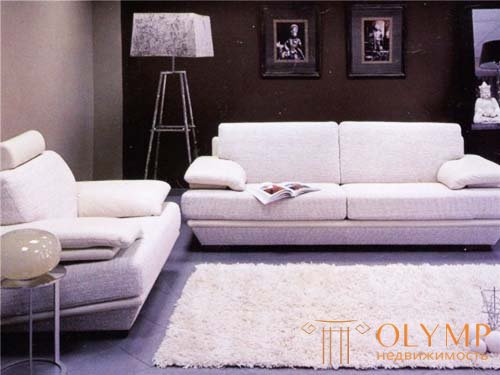
Style Contemporary in the interior, photo
Children's modern style. The finished set of furniture is bright, "toy", which includes a cot, lockers, workplace. The "trick" of the nursery's interior is plastic stickers of various scenes on the walls and textile bag-shelves for storing toys and things.
Living room in contemporary style. Modular wall for TV, video and music equipment, with space for storing discs, bookcase for magazines and books, upholstered furniture in covers of rich color with a huge amount of decorative square pillows.
Accents of modern style contemporary. This style is designed so that you yourself will fill the house with decorative things with lovely hearts. Vases with flowers, paintings and photographs in frames on the walls and shelves, blankets, flowers in colorful pots, souvenirs brought from travels, drawers and wooden chests - all fit perfectly into the interior and fill it with warmth and comfort.

Style Contemporary in the interior, photo
To create a style of contemporary, various finishing materials are used, but artificial ones predominate. As the floor covering most often choose a laminate, preferably light shades. In the furniture and decor there are glass and chrome-plated metal.
The style of contemporary music itself does not exclude the presence of elements of other styles, on the contrary, this style can serve as a neutral background for new interpretations of other styles - ethno, classic, retro. Mass-produced furniture is easily transformed, which makes it easy to change the interior.
One of the important trends in the style of “contemporary” is the unification of space (although this was not typical of Soviet interiors). The desire of people to get maximum space in a limited area is expressed in the principles of open planning and visual zoning techniques.
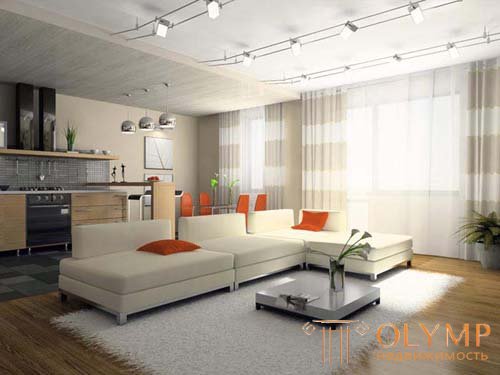
Style Contemporary in the interior, photo
Modular structures, furniture, screens and curtains, changes in the level or floor covering, ceiling height and similar elements are used as “borders” between different functional areas. At the same time, the maximum benefit is derived from each construction. One of the difficulties for the designer working with this style is the need to meticulously calculate the space in order to precisely fit each piece of interior to the place allotted to him by fate. Here everything is thought out and weighed, which makes the style of “contemporary” with antique ideas about the harmony of space.
Ultimate functionality requires taking into account the lifestyle and personal characteristics of the inhabitants of the premises. That is why contemporary-styled interiors are always unique. This is the paradox of “contemporary”: on the basis of standard, most ordinary things, an original environment is created expressing the uniqueness of a person. The style gives the designer the same freedom as a toy designer gives the child: it seems that all the details are the same, and the possible combinations cannot be counted.
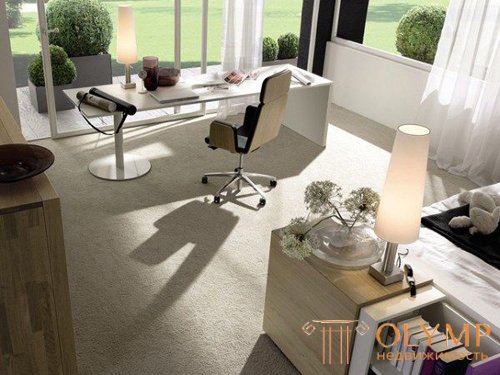
Style Contemporary in the interior, photo
The main ground for the use of contemporary style in addition to small apartments became office space. They have to themselves accuracy, severity, seeming performance, at the same time not pushing away neither lovers of the classics, nor adherents of the high-tech style. From the point of view of ergonomics and convenience of the workplace - this style is just perfect, and a huge number of mobile structures and modular elements allow any employee to express their individuality when organizing a workplace. The color scheme of the office of “contemporary” is neutral, mostly pastel shades. Bright spots can be paintings on the walls or elements of the company logo.
Contemporary - describes the most democratic style that corresponds to modern life.
Interiors in the style of contemporary can not be attributed to the traditional styles that cite historical eras, but they also meet the modern requirements of comfort, simplicity, functionality and accessibility.
This style is ideal for small modern apartments as it is easily transformed and adjusted.
Что бы оставить комментарий войдите
Комментарии (0)